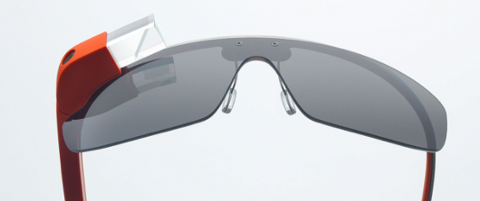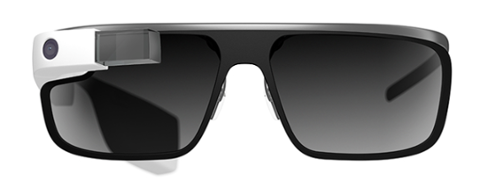 The voice-recognition capabilities of Google Glass could come in particularly handy if the wearer is attempting an acrobatic feat.[/caption] Forget about reading your daily newspaper on a tablet or smartphone—if Google has its way, you could soon be scanning articles via its Google Glass eyewear. At this year’s SXSW conference in Austin, Google revealed that it’s developing a New York Times app that will provide a headline, byline, and image to the tiny screen embedded in the Google Glass lens; tapping the hardware will prompt the app to actually read the story aloud. According to Engadget and a number of other publications that covered Google’s presentation, the search-engine giant and the newspaper are tinkering with another feature that will alert the Google Glass user to news at its breaks. Google Glass’s voice-recognition capabilities will also have a large role to play with the Gmail app in development, with the ability to answer incoming emails via speech. TechCrunch reported that Evernote and Skitch, along with social-networking app Path, are queued up for Google Glass appearances, at least based on their cameos during Google’s presentation. Google has moved rapidly over the past few weeks to show off Google Glass as a viable product. In February, for example, it launched a Website demonstrating the hardware and software features. Users can say, “Ok glass” to wake the device up, or “Take a picture” to snap a point-of-view image. They can ask questions (“How many miles between New York City and Washington DC?”) and receive answers on the embedded screen. Despite all that flash and sizzle, Google is keeping some technical specs out of sight for the time being. Google is inviting potential users to apply for its Glass Explorer program, which will require ordering the Glass Explorer Edition (a prototype model, presumably) for $1,500 plus tax. For those who care about aesthetics, the devices will come in five colors— charcoal, tangerine, shale, cotton, and sky. Many questions still remain: how easy is it to build apps for Glass? What’s the battery life like? How much damage can the eyewear take in the real world? Those are the sorts of questions that can only be answered once Google actually releases its augmented-reality project for mass consumption. Image: Google
The voice-recognition capabilities of Google Glass could come in particularly handy if the wearer is attempting an acrobatic feat.[/caption] Forget about reading your daily newspaper on a tablet or smartphone—if Google has its way, you could soon be scanning articles via its Google Glass eyewear. At this year’s SXSW conference in Austin, Google revealed that it’s developing a New York Times app that will provide a headline, byline, and image to the tiny screen embedded in the Google Glass lens; tapping the hardware will prompt the app to actually read the story aloud. According to Engadget and a number of other publications that covered Google’s presentation, the search-engine giant and the newspaper are tinkering with another feature that will alert the Google Glass user to news at its breaks. Google Glass’s voice-recognition capabilities will also have a large role to play with the Gmail app in development, with the ability to answer incoming emails via speech. TechCrunch reported that Evernote and Skitch, along with social-networking app Path, are queued up for Google Glass appearances, at least based on their cameos during Google’s presentation. Google has moved rapidly over the past few weeks to show off Google Glass as a viable product. In February, for example, it launched a Website demonstrating the hardware and software features. Users can say, “Ok glass” to wake the device up, or “Take a picture” to snap a point-of-view image. They can ask questions (“How many miles between New York City and Washington DC?”) and receive answers on the embedded screen. Despite all that flash and sizzle, Google is keeping some technical specs out of sight for the time being. Google is inviting potential users to apply for its Glass Explorer program, which will require ordering the Glass Explorer Edition (a prototype model, presumably) for $1,500 plus tax. For those who care about aesthetics, the devices will come in five colors— charcoal, tangerine, shale, cotton, and sky. Many questions still remain: how easy is it to build apps for Glass? What’s the battery life like? How much damage can the eyewear take in the real world? Those are the sorts of questions that can only be answered once Google actually releases its augmented-reality project for mass consumption. Image: Google Google Glass Apps Make an Appearance at SXSW
[caption id="attachment_8423" align="aligncenter" width="618"]  The voice-recognition capabilities of Google Glass could come in particularly handy if the wearer is attempting an acrobatic feat.[/caption] Forget about reading your daily newspaper on a tablet or smartphone—if Google has its way, you could soon be scanning articles via its Google Glass eyewear. At this year’s SXSW conference in Austin, Google revealed that it’s developing a New York Times app that will provide a headline, byline, and image to the tiny screen embedded in the Google Glass lens; tapping the hardware will prompt the app to actually read the story aloud. According to Engadget and a number of other publications that covered Google’s presentation, the search-engine giant and the newspaper are tinkering with another feature that will alert the Google Glass user to news at its breaks. Google Glass’s voice-recognition capabilities will also have a large role to play with the Gmail app in development, with the ability to answer incoming emails via speech. TechCrunch reported that Evernote and Skitch, along with social-networking app Path, are queued up for Google Glass appearances, at least based on their cameos during Google’s presentation. Google has moved rapidly over the past few weeks to show off Google Glass as a viable product. In February, for example, it launched a Website demonstrating the hardware and software features. Users can say, “Ok glass” to wake the device up, or “Take a picture” to snap a point-of-view image. They can ask questions (“How many miles between New York City and Washington DC?”) and receive answers on the embedded screen. Despite all that flash and sizzle, Google is keeping some technical specs out of sight for the time being. Google is inviting potential users to apply for its Glass Explorer program, which will require ordering the Glass Explorer Edition (a prototype model, presumably) for $1,500 plus tax. For those who care about aesthetics, the devices will come in five colors— charcoal, tangerine, shale, cotton, and sky. Many questions still remain: how easy is it to build apps for Glass? What’s the battery life like? How much damage can the eyewear take in the real world? Those are the sorts of questions that can only be answered once Google actually releases its augmented-reality project for mass consumption. Image: Google
The voice-recognition capabilities of Google Glass could come in particularly handy if the wearer is attempting an acrobatic feat.[/caption] Forget about reading your daily newspaper on a tablet or smartphone—if Google has its way, you could soon be scanning articles via its Google Glass eyewear. At this year’s SXSW conference in Austin, Google revealed that it’s developing a New York Times app that will provide a headline, byline, and image to the tiny screen embedded in the Google Glass lens; tapping the hardware will prompt the app to actually read the story aloud. According to Engadget and a number of other publications that covered Google’s presentation, the search-engine giant and the newspaper are tinkering with another feature that will alert the Google Glass user to news at its breaks. Google Glass’s voice-recognition capabilities will also have a large role to play with the Gmail app in development, with the ability to answer incoming emails via speech. TechCrunch reported that Evernote and Skitch, along with social-networking app Path, are queued up for Google Glass appearances, at least based on their cameos during Google’s presentation. Google has moved rapidly over the past few weeks to show off Google Glass as a viable product. In February, for example, it launched a Website demonstrating the hardware and software features. Users can say, “Ok glass” to wake the device up, or “Take a picture” to snap a point-of-view image. They can ask questions (“How many miles between New York City and Washington DC?”) and receive answers on the embedded screen. Despite all that flash and sizzle, Google is keeping some technical specs out of sight for the time being. Google is inviting potential users to apply for its Glass Explorer program, which will require ordering the Glass Explorer Edition (a prototype model, presumably) for $1,500 plus tax. For those who care about aesthetics, the devices will come in five colors— charcoal, tangerine, shale, cotton, and sky. Many questions still remain: how easy is it to build apps for Glass? What’s the battery life like? How much damage can the eyewear take in the real world? Those are the sorts of questions that can only be answered once Google actually releases its augmented-reality project for mass consumption. Image: Google
 The voice-recognition capabilities of Google Glass could come in particularly handy if the wearer is attempting an acrobatic feat.[/caption] Forget about reading your daily newspaper on a tablet or smartphone—if Google has its way, you could soon be scanning articles via its Google Glass eyewear. At this year’s SXSW conference in Austin, Google revealed that it’s developing a New York Times app that will provide a headline, byline, and image to the tiny screen embedded in the Google Glass lens; tapping the hardware will prompt the app to actually read the story aloud. According to Engadget and a number of other publications that covered Google’s presentation, the search-engine giant and the newspaper are tinkering with another feature that will alert the Google Glass user to news at its breaks. Google Glass’s voice-recognition capabilities will also have a large role to play with the Gmail app in development, with the ability to answer incoming emails via speech. TechCrunch reported that Evernote and Skitch, along with social-networking app Path, are queued up for Google Glass appearances, at least based on their cameos during Google’s presentation. Google has moved rapidly over the past few weeks to show off Google Glass as a viable product. In February, for example, it launched a Website demonstrating the hardware and software features. Users can say, “Ok glass” to wake the device up, or “Take a picture” to snap a point-of-view image. They can ask questions (“How many miles between New York City and Washington DC?”) and receive answers on the embedded screen. Despite all that flash and sizzle, Google is keeping some technical specs out of sight for the time being. Google is inviting potential users to apply for its Glass Explorer program, which will require ordering the Glass Explorer Edition (a prototype model, presumably) for $1,500 plus tax. For those who care about aesthetics, the devices will come in five colors— charcoal, tangerine, shale, cotton, and sky. Many questions still remain: how easy is it to build apps for Glass? What’s the battery life like? How much damage can the eyewear take in the real world? Those are the sorts of questions that can only be answered once Google actually releases its augmented-reality project for mass consumption. Image: Google
The voice-recognition capabilities of Google Glass could come in particularly handy if the wearer is attempting an acrobatic feat.[/caption] Forget about reading your daily newspaper on a tablet or smartphone—if Google has its way, you could soon be scanning articles via its Google Glass eyewear. At this year’s SXSW conference in Austin, Google revealed that it’s developing a New York Times app that will provide a headline, byline, and image to the tiny screen embedded in the Google Glass lens; tapping the hardware will prompt the app to actually read the story aloud. According to Engadget and a number of other publications that covered Google’s presentation, the search-engine giant and the newspaper are tinkering with another feature that will alert the Google Glass user to news at its breaks. Google Glass’s voice-recognition capabilities will also have a large role to play with the Gmail app in development, with the ability to answer incoming emails via speech. TechCrunch reported that Evernote and Skitch, along with social-networking app Path, are queued up for Google Glass appearances, at least based on their cameos during Google’s presentation. Google has moved rapidly over the past few weeks to show off Google Glass as a viable product. In February, for example, it launched a Website demonstrating the hardware and software features. Users can say, “Ok glass” to wake the device up, or “Take a picture” to snap a point-of-view image. They can ask questions (“How many miles between New York City and Washington DC?”) and receive answers on the embedded screen. Despite all that flash and sizzle, Google is keeping some technical specs out of sight for the time being. Google is inviting potential users to apply for its Glass Explorer program, which will require ordering the Glass Explorer Edition (a prototype model, presumably) for $1,500 plus tax. For those who care about aesthetics, the devices will come in five colors— charcoal, tangerine, shale, cotton, and sky. Many questions still remain: how easy is it to build apps for Glass? What’s the battery life like? How much damage can the eyewear take in the real world? Those are the sorts of questions that can only be answered once Google actually releases its augmented-reality project for mass consumption. Image: Google 

